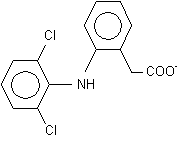Byline: F. Ahmed, P. Mohan, C. Barua, D. Dutta
Interactions between nonsteroidal antiinflammatory drugs (NSAIDs) and other drugs occur relatively frequently because of the wide use of the former. Enrofloxacin, a fluoroquinolone antimicrobial approved exclusively for veterinary use has a broad spectrum of antibacterial activity and is used in the treatment of septicemia, respiratory tract, urinary tract, skin, soft tissue, bone and joint infections etc. Diclofenac sodium, a nonsteroidal antiinflammatory drug is commonly used for the therapeutic management of pain, inflammatory conditions, rheumatoid arthritis and related disorders. Clinicians often prescribe both, an antimicrobial agent and an antiinflammatory agent at the same time to get the desired effect in animals. Since there are many reports of drug interaction among the NSAIDs and fluoroquinolone compounds, it was thought worthwhile to study the effect of diclofenac sodium on the pharmacokinetics of enrofloxacin, to assess the safety and/or potential toxicity.
The study was conducted in six healthy calves in two phases (n=6 per group) by a cross over design with adequate wash out period of 21 days between each trial. In both the phases enrofloxacin was administered intravenously into left jugular vein at the dose of 5 mg/kg body weight. In the second phase diclofenac sodium was injected intramuscularly (1 mg/kg) in the gluteal region, half an hour before administration of enrofloxacin. The same animals were used again for diclofenac sodium co-administration with enrofloxacin after sufficient washout period. Blood samples (2-3 ml) were collected by jugular venepuncture into heparinised tubes. The samples prior to and after administration of drug were collected at various time intervals up to 96 hours following enrofloxacin administration. Plasma was harvested by centrifugation at 3000 rpm for 15 min and stored at -5 [degrees]C till analysis for enrofloxacin. For quantitative determination of enrofloxacin in plasma, HPLC method[1] was followed with some modifications.
Plasma concentrations versus time data of enrofloxacin obtained during the study were utilized for calculating various pharmacokinetic parameters using noncompartmental method of analysis. Differences between respective means of pharmacokinetic parameters were evaluated using Student's ' t ' test. P values < 0.01 were considered to be statistically significant.
The various pharmacokinetic parameters calculated by the non compartmental method of analysis after enrofloxacin alone and with diclofenac sodium are presented in [Table:1].
The elimination half-life (t1/2) of enrofloxacin was found to be 1.38[+ or -]0.05 h as compared to 1.01 h in dairy cows.[2] However, a slightly longer t1/2 of 1.7 h in lactating cows of Ayrshire breed was reported.[3] The elimination half-life (t1/2) in diclofenac sodium pretreated calves was 1.67[+ or -]0.13 h, which showed no significant difference with the t1/2 value of single dose enrofloxacin.
The AUC for enrofloxacin in the present study, was 11.15[+ or -]1.06 [micro]g.h/ml after a single intravenous dose (5 mg/kg). The AUC in case of combined administration (12.30 [+ or -] 1.16 [micro]g.h/ml) was slightly higher, but statistically insignificant.
The apparent volume of distribution (Vd) obtained in the present study was 917[+ or -]0.057 ml/kg. Fluoroquinolones, in general, have excellent tissue penetration as reflected by Vd in the present study. The Vd in case of combined administration (1068[+ or -]0.07 ml/kg) was slightly increased but not found to be statistically significant from that of single intravenous administration of enrofloxacin.
The total body clearance (ClB) obtained in the present study (467.51[+ or -]41.36 ml/h/kg) was much lower than the lactating cows.[2] This difference might be due to both age and sex difference between the two studies. The ClB value in case of combined administration (428.51[+ or -]47.00 ml/h/kg) was decreased. This might be possible either due to decreased metabolism or higher protein binding or slower excretion of enrofloxacin. But no significant difference between these two values was found.
In the present study, mean residence time (MRT) of enrofloxacin was 1.99[+ or -]0.08 h. The present observation is in agreement with the earlier report (1.80 h) in lactating cows.[4] MRT value in case of combined administration (2.41[+ or -]0.18 h) was lower. Again no significant difference with the MRT value following single intravenous administration of enrofloxacin was found. So, it can be concluded that diclofenac sodium does not alter the pharmacokinetic profile of enrofloxacin (i.v.) significantly at therapeutic dose.
Concurrent administration of therapeutic doses of diclofenac sodium and enrofloxacin in calves appear to be safe.
References
1. Teja-Isvadharm P, Keratithakul D, Watt G, Webster HK, Edstein MD. Measurement of ciprofloxacin in human plasma, whole blood and erythrocytes by high performance liquid chromatography. Ther Drug Monit 1991;13:263-7.
2. Malbe M, Salonen M, Fang W, Oopik T, Jalakas M, Klaassen M, Sandholm M. Disposition of enrofloxacin (Baytril) into the udder after intravenous and intra- arterial injections into dairy cows. Zentralbl Veterinarmed A 1996;43:377-86.
3. Scheer M. Concentrations of active ingredient in the serum and tissues after oral and parenteral administration of Baytril. Vet Med Rev 1987;2:104-18.
4. Kaartinen, L, Salonene M, Alli L, Pyorala S. Pharmacokinetics of enrofloxacin after single intravenous, intramuscular and subcutaneous injections in lactating cow. J Vet Pharmacol Ther 1995;18:357-62.
COPYRIGHT 2005 Medknow Publications
COPYRIGHT 2005 Gale Group



